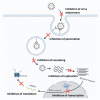Polysaccharides and Their Derivatives as Potential Antiviral Molecules
- PMID: 35216019
- PMCID: PMC8879384
- DOI: 10.3390/v14020426
Polysaccharides and Their Derivatives as Potential Antiviral Molecules
Abstract
In the current context of the COVID-19 pandemic, it appears that our scientific resources and the medical community are not sufficiently developed to combat rapid viral spread all over the world. A number of viruses causing epidemics have already disseminated across the world in the last few years, such as the dengue or chinkungunya virus, the Ebola virus, and other coronavirus families such as Middle East respiratory syndrome (MERS-CoV) and severe acute respiratory syndrome (SARS-CoV). The outbreaks of these infectious diseases have demonstrated the difficulty of treating an epidemic before the creation of vaccine. Different antiviral drugs already exist. However, several of them cause side effects or have lost their efficiency because of virus mutations. It is essential to develop new antiviral strategies, but ones that rely on more natural compounds to decrease the secondary effects. Polysaccharides, which have come to be known in recent years for their medicinal properties, including antiviral activities, are an excellent alternative. They are essential for the metabolism of plants, microorganisms, and animals, and are directly extractible. Polysaccharides have attracted more and more attention due to their therapeutic properties, low toxicity, and availability, and seem to be attractive candidates as antiviral drugs of tomorrow.
Keywords: SARS-CoV; antiviral activities; polysaccharides; replication inhibition; severe acute respiratory syndrome; side effects; virus and coronavirus.
Conflict of interest statement
The authors declare no conflict of interest.
Figures






References
-
- Watson D.G. Pharmaceutical Chemistry, International Edition E-Book. Elsevier; Amsterdam, The Netherlands: 2011.
Publication types
MeSH terms
Substances
LinkOut - more resources
Full Text Sources
Miscellaneous

